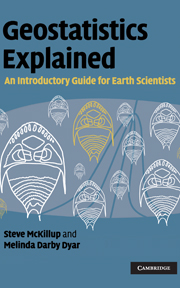Book contents
- Frontmatter
- Contents
- Preface
- 1 Introduction
- 2 “Doing science”: hypotheses, experiments and disproof
- 3 Collecting and displaying data
- 4 Introductory concepts of experimental design
- 5 Doing science responsibly and ethically
- 6 Probability helps you make a decision about your results
- 7 Working from samples: data, populations and statistics
- 8 Normal distributions: tests for comparing the means of one and two samples
- 9 Type 1 and Type 2 error, power and sample size
- 10 Single-factor analysis of variance
- 11 Multiple comparisons after ANOVA
- 12 Two-factor analysis of variance
- 13 Important assumptions of analysis of variance, transformations and a test for equality of variances
- 14 Two-factor analysis of variance without replication, and nested analysis of variance
- 15 Relationships between variables: linear correlation and linear regression
- 16 Linear regression
- 17 Non-parametric statistics
- 18 Non-parametric tests for nominal scale data
- 19 Non-parametric tests for ratio, interval or ordinal scale data
- 20 Introductory concepts of multivariate analysis
- 21 Introductory concepts of sequence analysis
- 22 Introductory concepts of spatial analysis
- 23 Choosing a test
- Appendices
- References
- Index
18 - Non-parametric tests for nominal scale data
Published online by Cambridge University Press: 05 June 2012
- Frontmatter
- Contents
- Preface
- 1 Introduction
- 2 “Doing science”: hypotheses, experiments and disproof
- 3 Collecting and displaying data
- 4 Introductory concepts of experimental design
- 5 Doing science responsibly and ethically
- 6 Probability helps you make a decision about your results
- 7 Working from samples: data, populations and statistics
- 8 Normal distributions: tests for comparing the means of one and two samples
- 9 Type 1 and Type 2 error, power and sample size
- 10 Single-factor analysis of variance
- 11 Multiple comparisons after ANOVA
- 12 Two-factor analysis of variance
- 13 Important assumptions of analysis of variance, transformations and a test for equality of variances
- 14 Two-factor analysis of variance without replication, and nested analysis of variance
- 15 Relationships between variables: linear correlation and linear regression
- 16 Linear regression
- 17 Non-parametric statistics
- 18 Non-parametric tests for nominal scale data
- 19 Non-parametric tests for ratio, interval or ordinal scale data
- 20 Introductory concepts of multivariate analysis
- 21 Introductory concepts of sequence analysis
- 22 Introductory concepts of spatial analysis
- 23 Choosing a test
- Appendices
- References
- Index
Summary
Introduction
Earth scientists sometimes collect data for which the sampling or experimental units can be assigned to two or more discrete and mutually exclusive categories that are contingent on each other. Consider a paleomagnetic study of the orientation of Earth's magnetic field using cores collected from the sea floor on a traverse perpendicular to the mid-ocean ridge. Roughly 55% of the core samples show the magnetic field pointing north and the remaining 45% show the magnetic field pointing south. These directions are discrete and mutually exclusive categories: a rock may be magnetized to point to the north or the south, but it cannot ever be both (the case of an in-between magnetization recorded during a reversal is so rare that it can be considered negligible). These two possibilities, north vs. south, also make up the entire set of possible outcomes and are therefore contingent upon each other: for a sample of 100 cores, a decrease in the number in one category (e.g. north-polarized rocks) must be accompanied by an increase in the number in the other (south-polarized rocks) and vice versa.
These are nominal scale data (Chapter 3). The questions researchers ask about these data are the sort asked about any sample(s) from a population.
First, you may want to know the probability that a sample has been taken from a population with a known or expected proportion within each of two or more categories.
- Type
- Chapter
- Information
- Geostatistics ExplainedAn Introductory Guide for Earth Scientists, pp. 230 - 246Publisher: Cambridge University PressPrint publication year: 2010

